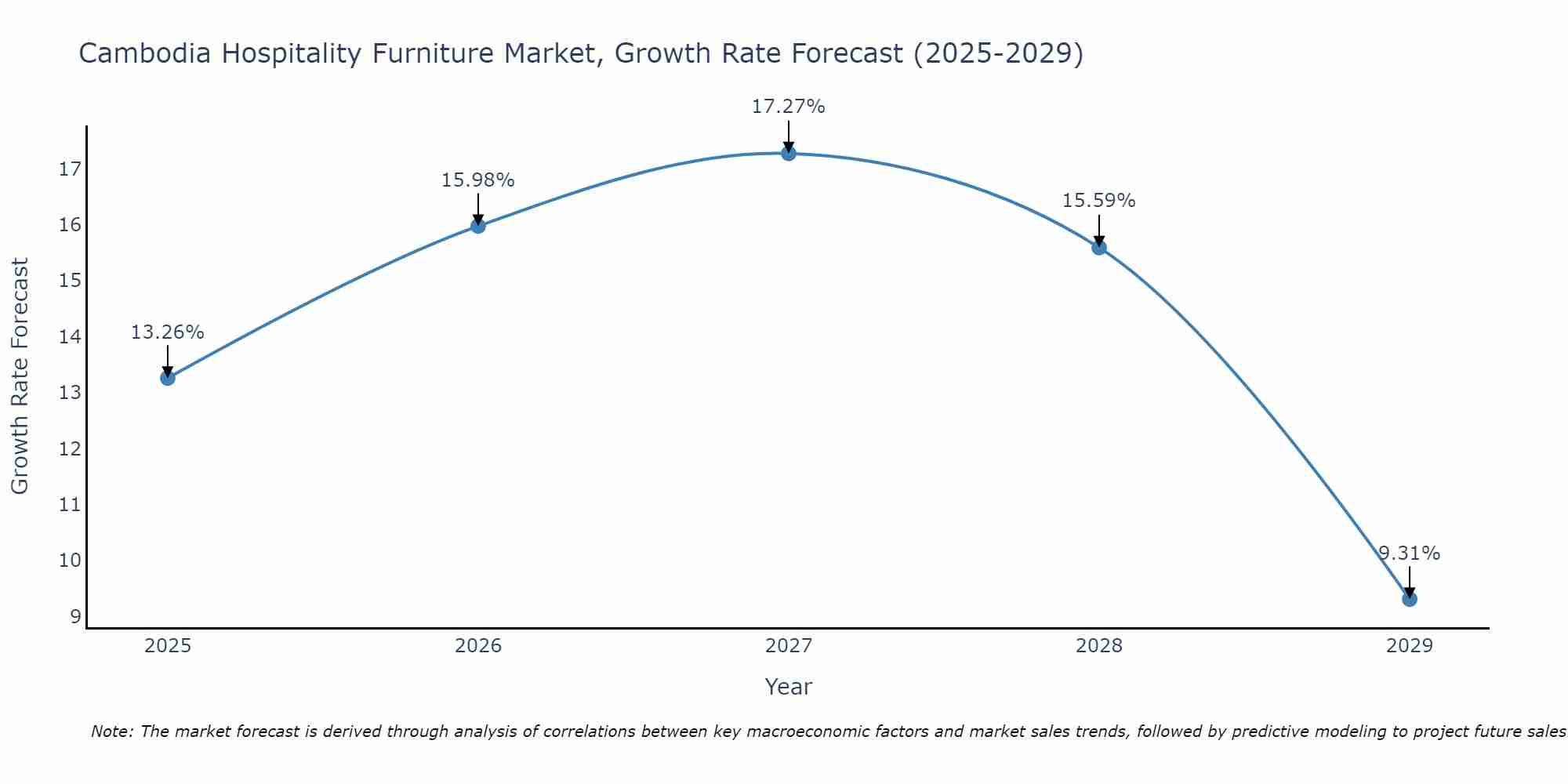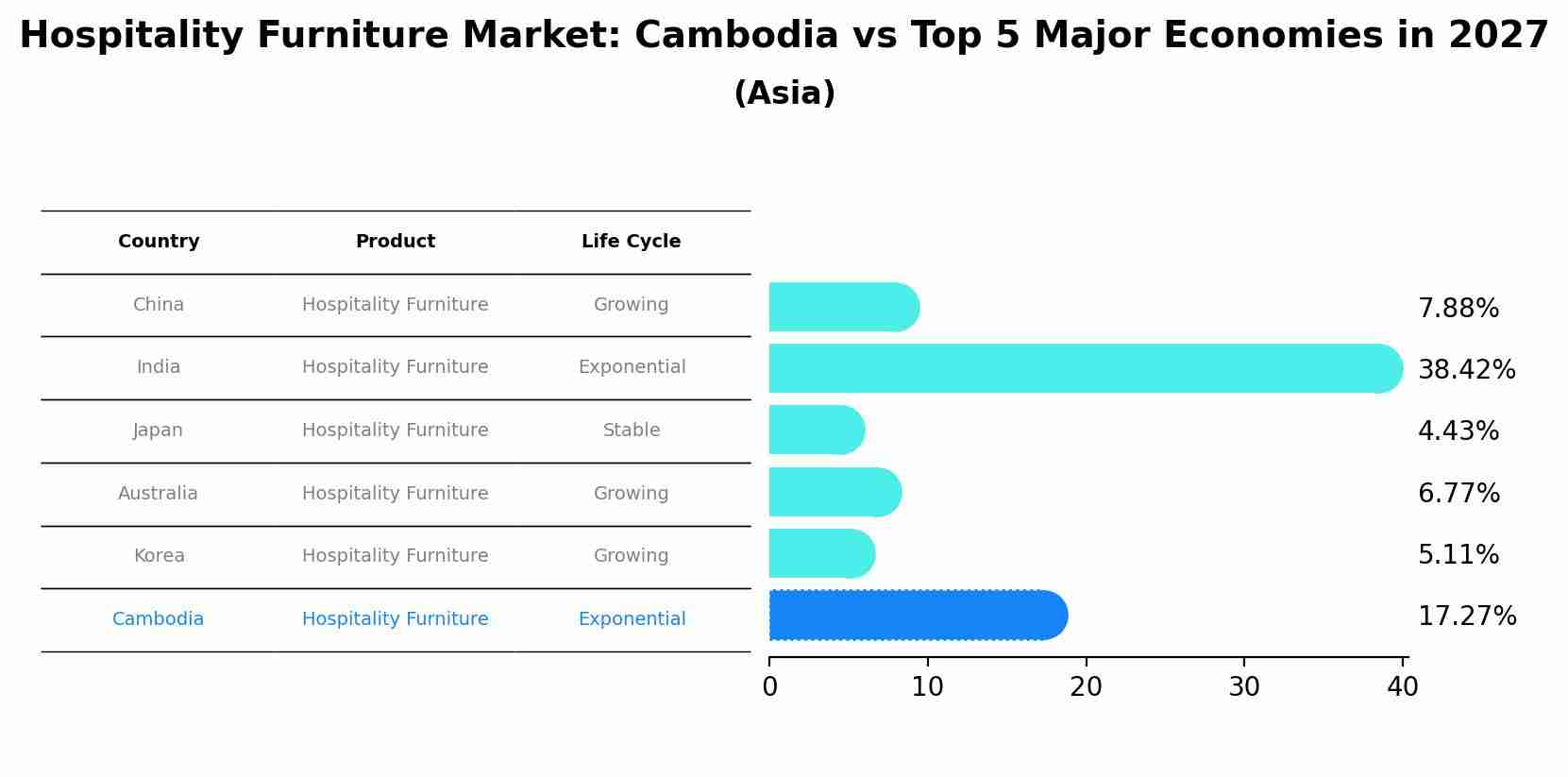Cambodia Hospitality Furniture Market Outlook | COVID-19 IMPACT, Value, Share, Forecast, Trends, Size, Revenue, Industry, Analysis, Growth & Companies
| Product Code: ETC371913 | Publication Date: Aug 2022 | Updated Date: Jul 2025 | Product Type: Market Research Report | |
| Publisher: 6Wresearch | Author: Sumit Sagar | No. of Pages: 75 | No. of Figures: 35 | No. of Tables: 20 |
Cambodia Hospitality Furniture Market Size Growth Rate
The Cambodia Hospitality Furniture Market is projected to witness mixed growth rate patterns during 2025 to 2029. Starting at 13.26% in 2025, the market peaks at 17.27% in 2027, and settles at 9.31% by 2029.

Hospitality Furniture Market: Cambodia vs Top 5 Major Economies in 2027 (Asia)
By 2027, the Hospitality Furniture market in Cambodia is anticipated to reach a growth rate of 17.27%, as part of an increasingly competitive Asia region, where China remains at the forefront, supported by India, Japan, Australia and South Korea, driving innovations and market adoption across sectors.

Cambodia Hospitality Furniture Market Synopsis
The Cambodia hospitality furniture market is experiencing steady growth driven by the country`s expanding tourism industry and increasing investments in the hospitality sector. With a rise in the number of hotels, resorts, and restaurants, there is a growing demand for high-quality and stylish furniture to enhance the guest experience. The market offers a diverse range of products including beds, seating, tables, and décor items, catering to different preferences and budgets. Key trends in the market include a preference for eco-friendly and sustainable materials, as well as a focus on modern and contemporary designs. International and local furniture manufacturers and suppliers are actively participating in the market to meet the evolving needs of the hospitality industry, presenting opportunities for further growth and innovation in the sector.
Cambodia Hospitality Furniture Market Trends
The Cambodia Hospitality Furniture Market is currently experiencing a trend towards eco-friendly and sustainable materials as hotels and resorts in the region strive to enhance their environmental responsibility and appeal to eco-conscious travelers. Bamboo, rattan, reclaimed wood, and recycled materials are gaining popularity for furniture pieces due to their durability, unique aesthetic, and minimal environmental impact. Additionally, there is a growing demand for multifunctional and space-saving furniture designs to accommodate the trend of smaller living spaces and maximize functionality in hospitality settings. Customization options are also on the rise as hotels seek to create distinctive and memorable guest experiences through bespoke furniture pieces that reflect the local culture and identity of Cambodia.
Cambodia Hospitality Furniture Market Challenges
In the Cambodia Hospitality Furniture Market, challenges include a limited supply chain for high-quality furniture materials, leading to sourcing difficulties and higher costs for businesses. Additionally, there is a lack of skilled labor in the furniture manufacturing sector, affecting production capabilities and craftsmanship. The market also faces competition from imported furniture brands, which offer a wider variety of styles and designs at competitive prices. Furthermore, fluctuations in raw material prices and currency exchange rates can impact the profitability of businesses operating in this sector. Overall, addressing these challenges will require investments in infrastructure, technology, and skills development to enhance the competitiveness of the Cambodia Hospitality Furniture Market.
Cambodia Hospitality Furniture Market Investment Opportunities
Investment opportunities in the Cambodia Hospitality Furniture Market are promising due to the country`s growing tourism industry and increasing demand for quality accommodations. With the rise of hotels, resorts, and other hospitality establishments, there is a need for stylish, durable, and functional furniture. Investors can capitalize on this trend by supplying a range of furniture products such as beds, sofas, tables, and chairs tailored to the needs of the hospitality sector. Additionally, there is potential for customization and offering eco-friendly options to align with the growing sustainability movement in the industry. Collaborating with local manufacturers or establishing a production facility in Cambodia can also provide cost advantages and quicker access to the market. Overall, the Cambodia Hospitality Furniture Market presents a lucrative opportunity for investors looking to tap into the thriving hospitality sector.
Jordan Agar Market Government Policies
Government policies in Cambodia related to the hospitality furniture market involve regulations on importing raw materials, quality standards for manufacturing, and taxation on furniture sales. The government imposes tariffs on imported raw materials used in furniture production, which can impact manufacturing costs for suppliers. Quality standards and certifications are required to ensure the safety and durability of furniture products in the market. Additionally, sales of furniture are subject to value-added tax (VAT) and other taxes, affecting the overall pricing and competitiveness of the industry. These policies play a significant role in shaping the landscape of the hospitality furniture market in Cambodia, influencing production costs, product quality, and market dynamics.
Cambodia Hospitality Furniture Market Future Outlook
The future outlook for the Cambodia Hospitality Furniture Market appears promising as tourism continues to grow in the country, driving demand for quality accommodation and dining experiences. With the government`s focus on infrastructure development and promotion of the tourism sector, there is a rising trend of investment in hotels, resorts, and restaurants, creating opportunities for the hospitality furniture market. Additionally, the increasing popularity of eco-friendly and sustainable furniture designs is expected to influence consumer preferences, leading to a shift towards environmentally conscious products in the market. As Cambodia positions itself as a key tourist destination in Southeast Asia, the hospitality furniture market is likely to experience steady growth with a focus on innovation, quality, and sustainability to cater to the evolving needs of the industry.
Key Highlights of the Report:
- Cambodia Hospitality Furniture Market Outlook
- Market Size of Cambodia Hospitality Furniture Market, 2021
- Forecast of Cambodia Hospitality Furniture Market, 2031
- Historical Data and Forecast of Cambodia Hospitality Furniture Revenues & Volume for the Period 2018 - 2031
- Cambodia Hospitality Furniture Market Trend Evolution
- Cambodia Hospitality Furniture Market Drivers and Challenges
- Cambodia Hospitality Furniture Price Trends
- Cambodia Hospitality Furniture Porter's Five Forces
- Cambodia Hospitality Furniture Industry Life Cycle
- Historical Data and Forecast of Cambodia Hospitality Furniture Market Revenues & Volume By Type for the Period 2018 - 2031
- Historical Data and Forecast of Cambodia Hospitality Furniture Market Revenues & Volume By Wooden Furniture for the Period 2018 - 2031
- Historical Data and Forecast of Cambodia Hospitality Furniture Market Revenues & Volume By Leather & Fabric Furniture for the Period 2018 - 2031
- Historical Data and Forecast of Cambodia Hospitality Furniture Market Revenues & Volume By Metal Furniture for the Period 2018 - 2031
- Historical Data and Forecast of Cambodia Hospitality Furniture Market Revenues & Volume By Others for the Period 2018 - 2031
- Historical Data and Forecast of Cambodia Hospitality Furniture Market Revenues & Volume By Applications for the Period 2018 - 2031
- Historical Data and Forecast of Cambodia Hospitality Furniture Market Revenues & Volume By Economy Hotel for the Period 2018 - 2031
- Historical Data and Forecast of Cambodia Hospitality Furniture Market Revenues & Volume By Extended-stay Hotel for the Period 2018 - 2031
- Historical Data and Forecast of Cambodia Hospitality Furniture Market Revenues & Volume By Full-service Hotel for the Period 2018 - 2031
- Historical Data and Forecast of Cambodia Hospitality Furniture Market Revenues & Volume By Luxury Hotel for the Period 2018 - 2031
- Historical Data and Forecast of Cambodia Hospitality Furniture Market Revenues & Volume By Others for the Period 2018 - 2031
- Historical Data and Forecast of Cambodia Hospitality Furniture Market Revenues & Volume By Industry Vertical for the Period 2018 - 2031
- Historical Data and Forecast of Cambodia Hospitality Furniture Market Revenues & Volume By Hotels & Restaurants for the Period 2018 - 2031
- Historical Data and Forecast of Cambodia Hospitality Furniture Market Revenues & Volume By Public Places for the Period 2018 - 2031
- Historical Data and Forecast of Cambodia Hospitality Furniture Market Revenues & Volume By Corporate Offices for the Period 2018 - 2031
- Historical Data and Forecast of Cambodia Hospitality Furniture Market Revenues & Volume By Others for the Period 2018 - 2031
- Cambodia Hospitality Furniture Import Export Trade Statistics
- Market Opportunity Assessment By Type
- Market Opportunity Assessment By Applications
- Market Opportunity Assessment By Industry Vertical
- Cambodia Hospitality Furniture Top Companies Market Share
- Cambodia Hospitality Furniture Competitive Benchmarking By Technical and Operational Parameters
- Cambodia Hospitality Furniture Company Profiles
- Cambodia Hospitality Furniture Key Strategic Recommendations
Frequently Asked Questions About the Market Study (FAQs):
- Single User License$ 1,995
- Department License$ 2,400
- Site License$ 3,120
- Global License$ 3,795
Search
Thought Leadership and Analyst Meet
Our Clients
Related Reports
- Afghanistan Apparel Market (2026-2032) | Growth, Outlook, Industry, Segmentation, Forecast, Size, Companies, Trends, Value, Share, Analysis & Revenue
- Canada Oil and Gas Market (2026-2032) | Share, Segmentation, Value, Industry, Trends, Forecast, Analysis, Size & Revenue, Growth, Competitive Landscape, Outlook, Companies
- Germany Breakfast Food Market (2026-2032) | Industry, Share, Growth, Size, Companies, Value, Analysis, Revenue, Trends, Forecast & Outlook
- Australia Briquette Market (2025-2031) | Growth, Size, Revenue, Forecast, Analysis, Trends, Value, Share, Industry & Companies
- Vietnam System Integrator Market (2025-2031) | Size, Companies, Analysis, Industry, Value, Forecast, Growth, Trends, Revenue & Share
- ASEAN and Thailand Brain Health Supplements Market (2025-2031) | Strategy, Consumer Insights, Analysis, Investment Trends, Opportunities, Growth, Size, Share, Industry, Revenue, Segments, Value, Segmentation, Supply, Forecast, Restraints, Outlook, Competition, Drivers, Trends, Demand, Pricing Analysis, Competitive, Strategic Insights, Companies, Challenges
- ASEAN Bearings Market (2025-2031) | Strategy, Consumer Insights, Analysis, Investment Trends, Opportunities, Growth, Size, Share, Industry, Revenue, Segments, Value, Segmentation, Supply, Forecast, Restraints, Outlook, Competition, Drivers, Trends, Demand, Pricing Analysis, Competitive, Strategic Insights, Companies, Challenges
- Europe Flooring Market (2025-2031) | Outlook, Share, Industry, Trends, Forecast, Companies, Revenue, Size, Analysis, Growth & Value
- Saudi Arabia Manlift Market (2025-2031) | Outlook, Size, Growth, Trends, Companies, Industry, Revenue, Value, Share, Forecast & Analysis
- Uganda Excavator, Crane, and Wheel Loaders Market (2025-2031) | Strategy, Consumer Insights, Analysis, Investment Trends, Opportunities, Growth, Size, Share, Industry, Revenue, Segments, Value, Segmentation, Supply, Forecast, Restraints, Outlook, Competition, Drivers, Trends, Demand, Pricing Analysis, Competitive, Strategic Insights, Companies, Challenges
Industry Events and Analyst Meet
Whitepaper
- Middle East & Africa Commercial Security Market Click here to view more.
- Middle East & Africa Fire Safety Systems & Equipment Market Click here to view more.
- GCC Drone Market Click here to view more.
- Middle East Lighting Fixture Market Click here to view more.
- GCC Physical & Perimeter Security Market Click here to view more.
6WResearch In News
- Doha a strategic location for EV manufacturing hub: IPA Qatar
- Demand for luxury TVs surging in the GCC, says Samsung
- Empowering Growth: The Thriving Journey of Bangladesh’s Cable Industry
- Demand for luxury TVs surging in the GCC, says Samsung
- Video call with a traditional healer? Once unthinkable, it’s now common in South Africa
- Intelligent Buildings To Smooth GCC’s Path To Net Zero


















